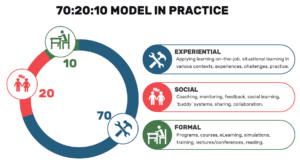Piecing it together: Scaffolding techniques for complex skill development
So, what exactly is scaffolding?
Picture this: you’re learning to ride a bike. You start with training wheels, gradually building confidence and balance. Then, you transition to a two-wheeler, with a guiding hand to keep you steady. Before you know it, you’re zooming off on your own! That’s scaffolding in action – providing temporary support structures to help learners navigate new skills and concepts (Jumaat & Tasir, 2014).
But why is scaffolding so important in adult learning? Well, as Vygotsky’s Zone of Proximal Development theory suggests, there’s a sweet spot between what learners can do independently and what they can achieve with guidance (Shabani et al., 2010). Scaffolding bridges that gap, chunking complex tasks into manageable steps and offering support along the way. This not only prevents cognitive overload but also keeps learners motivated and engaged.
Scaffolding in action
Now, let’s get practical. How can you weave scaffolding into your learning programs? Here are some top tips:

Start with the end in mind
Before you dive into design, clarify the complex skill you’re targeting. Break it down into its component parts, identifying the key steps and milestones learners need to hit. This’ll help you create a roadmap for your scaffolding journey!

Chunk it
Complex skills can be daunting. Make them more digestible by chunking content into bite-sized pieces, each building on the last. This step-by-step approach helps learners gain mastery gradually, without feeling overwhelmed (Choo, 2020). Remember, baby steps!

Mix up your media
Everyone has different preferences, so cater to various learning styles by using a mix of media in your scaffolding. Think videos for visual learners, podcasts for auditory processors, and hands-on activities for kineasthetic learners. The more variety, the better!

Guide with questioning
Socratic questioning is a powerful scaffolding tool. Pepper your content with thought-provoking questions that guide learners to connect the dots themselves. This not only deepens understanding but also fosters critical thinking skills.

Leverage social learning
Peer support can be a scaffolding gamechanger. Create opportunities for learners to collaborate, discuss, and problem-solve together. This social learning approach enhances engagement and exposes learners to diverse perspectives.

Gradually release responsibility
As learners gain mastery, begin to fade your scaffolding. Gradually increase task complexity while decreasing support. This “I do, we do, you do” method empowers learners to become self-directed and confident in their newly acquired skills.
There you have it – scaffolding demystified! By chunking complex skills, diversifying media, guiding with questions, leveraging social learning, and gradually releasing responsibility, you’ll create learning experiences that enable adult learners to piece together even the most challenging skills.
References
Choo, K. A. (2020). Scaffolding in the teaching and learning of mathematics: What does it mean? Journal of Physics: Conference Series, 1657(1), 012014. https://doi.org/10.1088/1742-6596/1657/1/012014
Jumaat, N. F., & Tasir, Z. (2014). Instructional scaffolding in online learning environment: A meta-analysis. Proceedings of the 2014 International Conference on Teaching and Learning in Computing and Engineering, 74-77. https://doi.org/10.1109/LaTiCE.2014.22
Shabani, K., Khatib, M., & Ebadi, S. (2010). Vygotsky’s zone of proximal development: Instructional implications and teachers’ professional development. English Language Teaching, 3(4), 237-248. https://doi.org/10.5539/elt.v3n4p237
Related articles



Bloom’s Taxonomy: A Guide for Creating Effective Learning Outcomes
Merrill’s Instructional Design Principles
The 70:20:10 Learning Model
